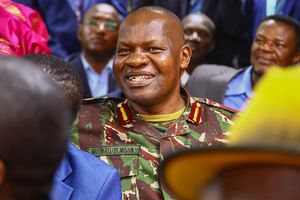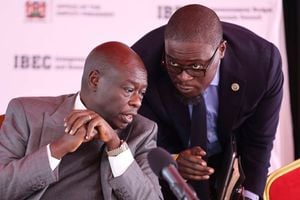
Somali traders load their lorries with imports at the Kismayo Sea Port on October 6, 2021.
| Mary Wambui | Nation Media GroupDiaspora News
Premium
Rebuilding Somalia: Kenyans thriving in liberated towns
Thousands of Kenyans are playing a huge role in rebuilding Somalia despite the constant fear of Al-Shabaab attacks in the war-torn nation.
Civilians in towns liberated by the Kenya Defence Forces (KDF), such as Kismayo and Dhobley in Afmadow District, are doing well in the lower Juba region just across the border.
Mr Daniel Matifa, 21, is an artisan who makes about Sh12,000 a day in one of the secured regions, where KDF have neutralised Al-Shabaab threats under the African Union Mission (Amisom) in Somalia.
“I’ve never seen them (Al-Shabaab) and I hope things stay that way. I’ve been here for two months, earning about Sh12,000 on a good day in this busy town. I enjoy my stay here, spending time with other Kenyans,” he told the Nation.
Mr Matifa left his home in Nguni, Mwingi District, to work as a labourer in Dhobley against the advice of his peers. He crossed through the border at Liboi and has never regretted his move.
Good security
Mr Said Egal, 34, has been in Somalia for a decade and runs a cosmetic store in Dhobley, which is doing quite well despite the challenges brought about by the Covid-19 pandemic. His main concern is not insecurity, but inability to move products from Somalia to Kenya.
“It’s challenging to sell the stock we purchase from Mogadishu to Kenya. Security is good; there is peace in Dhobley. Some people only fear that if Amisom troops pull out, things might take the shape of Afghanistan,” Mr Egal told the Nation.
Ms Jamila Ibrahim, 78, a Somali businesswoman who has been running a shop for more than 18 years, said business is good because Amisom troops carry out regular patrols.
“Amisom troops makes me happy because I know it means the threat of Al-Shabaab is diminished in Dhobley. My prayer to Amisom is to help us with more food,” she said.
Mr Taalil Mohammed, a Somali national who owns an electronics shop mostly stocked by goods from Kenya, offered. “We want authorities to tarmac the roads so the tow can grow. We have no fire engine; when a fire starts, we rely on the one in Garissa for assistance.”
Despite the challenge of clean drinking water and food, residents are slowly shaking off the effects of the war that has left their country poor, and for a long time, ungovernable.
Thriving trade
Dhobley is relatively peaceful with hotels, banks and other social economic activities thriving, boosted by trade between Garissa and Mogadishu. Of the six divisions of Amisom in Somalia, KDF troops are in Sector II and VI.
Sector II, which includes Dhobley, Ras Kamboni, Bilis Qooqaani, Afmadhow, Hoosingo and Tabta, among other smaller communities, is fully under KDF. Sector VI, which is in Kismayo town (Jubaland’s capital) is jointly patrolled by KDF, Burundian and Ethiopian troops.

KDF soldiers serving under Amisom guard Kismayo Sea Port on October 6, 2021
Amisom Kenya commander in Sector II, Brigadier Jeff Nyagah, said when Kenya launched operation Linda Nchi, Dhobley town had a population of about 4,000 people, but it now has over 30,000.
With an airstrip, all weather roads linking the town to other parts of Somalia, a level two hospital and a police station, it’s poised to experience even more growth so long as the Al-Shabaab are kept at bay.
The semblance of calm is also evident in Kismayo port, Jubaland’s main source of revenue. It was a beehive of activities on Wednesday morning when the Nation visited as traders loaded their imports into waiting trucks for distribution to various parts of the country.
KDF seized Kismayo from Al-Shabaab in an offensive code named Operation Sledge Hammer in 2012.
With less than 10 years since it was liberated from the militia who were using it to export charcoal to Qatar and Oman, the port is today helping Jubaland rebuild its liberated areas by acting as the main route for construction, textile and food imports and aid into Somalia.
Kismayo port managing director Ahmed Haji Adan said though the number of vessels docking had reduced since the pandemic hit the country, the town’s population since its liberation in 2012 has multiplied 50 times from about 10,000 to over half-a-million.
“This is all because of the peace that is being experienced here which can be attributed to three things; Allah, KDF troops and the people. We are seeing refugees returning home in Kismayo, which shows that something right is happening here that is attracting them,” said Mr Adan.
The port’s main access and exit points are manned by Jubaland forces, backed by KDF troops. Kenya Navy ships patrol the sea, supported by aerial surveillance that has reduced acts of piracy in the Indian Ocean.
Lieutenant Onesmus Katiwa, the Officer Commanding Special Boat Unit at Kismayo port, said KDF conducts maritime operations that include protecting vessels from terrorists, pirates and human traffickers.
“We also respond to signals from local fishermen in distress, conduct document verification and physical inspection of vessels, personnel and cargo,” he said.
Kismayo International Airport, also called Sayid Mohammed Abdille International Hassan Airport, which was previously in a shambles, has been refurbished and is now fully functional. From zero in 2014, it receives over 300 passengers weekly from local and international flights.
“We are back in business because of the security efforts by Amisom troops and Jubaland forces,” said Mr Abdi Sirad Ahmed, the managing director.
In the lower Juba region, about 35km east of the Kenya-Somali border, where one of KDF’s landmark battles with militia was witnessed on April 4 this year, the situation remains fluid.
Over 1,000 fighters attacked the KDF Hoosinga base but they were repelled. “Our troops had stocked enough ammo that sustained them until Kenya Air Force jets arrived on time to support the ground troops with air support,” said Major Shadrack Ng’etich, the base commander.
Over 300 Al-Shabaab militia were killed and their weapons captured in what KDF regards as one of their most successful defensive operations in Somalia to this day.
“The area is generally calm but the situation remains fluid due to the unpredictable nature of Al-Shabaab. We conduct day and night patrols to keep them away,” said Major Ng’etich.
Locals live in constant fear of attacks by the militia. “The situation is calm but at times they (militia) show up and attack those working with Amisom. If I speak on camera, my head will be cut off,” a local Imam said.





